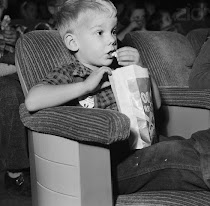At a screenwriting seminar, I once heard a panelist who had
pitched an idea to Stephen Spielberg say that Spielberg intermittently
interrupted him during their session, asking, "What's the audience feeling
now?
That's why, as a part of my pitching material - it also helps in the rewriting process - I include what I call an Action/Reaction-ometer diagram. Here's how it works:
As the above illustration shows, I have plotted two series of horizontal line graphs detailing the events and corresponding emotions of act one of my script, "Gray Matters." The top line graphs show the predominant events/actions that occur in these most crucial first pages, with each given a relative high/low value.The bottom line graph show the corresponding emotion/reaction to those actions/events, also with a high/low relational value.
Let me be more specific: In the middle of the chart, an event with one of the highest value ratings is when the protagonist, Hugh, has a "confrontation with Kaufman," his key rival. That's seen on the top line graph. The corresponding reaction - shown on the bottom line graph - is "bold," because Hugh has finally found enough courage to confront his arch nemesis.
Shortly after that event, we see one of the lowest value readings when "Hugh escapes" - top line graph - and is correspondingly "desperate" - bottom line graph.
If you look at the overall first act of "Gray Matters," you'll see that there are progressive and extreme emotional swings that conclude with an extreme low and then extreme high value at the end of the act (leading into plot point one). Which is exactly my intention.
Below is the Action/Reaction-ometer chart for act two. Same thing. You can see the consistent emotional swings throughout the act, ending in an extreme low value at the end of the middle act (leading into the second plot point and act three).
Sure, it's a relative and subjective process, but the point is to visually show the emotional ups and downs of the character and story - which will most likely mirror what the audience is experiencing. It's also a good way to show the depth and breadth of character and story throughout your entire script.
Is it rocket science? No. Is it helpful? It has been for me. And as I start to promote "Gray Matters," I hope that producers and agents can literally see that I've not only created a well designed story but one that takes them on a fully developed, emotional, and satisfying roller coaster ride.
And one about which they will feel deeply.














